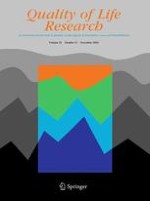20-05-2016
Using the ICF’s environmental factors framework to develop an item bank measuring built and natural environmental features affecting persons with disabilities
Gepubliceerd in: Quality of Life Research | Uitgave 11/2016
Log in om toegang te krijgenAbstract
Objectives
To develop a measure of natural environment and human-made change features (Chapter 2 of the international classification of functioning, disability, and health) and evaluate the influence of perceived barriers on health-related quality of life.
Methods
A sample of 570 adults with stroke, spinal cord injury, and traumatic brain injury residing in community settings reported their functioning in home, outdoor, and community settings (mean age = 47.0 years, SD = 16.1). They rated 18 items with a 5-point rating scale to describe the influence of barriers to moving around, seeing objects, hearing sounds, hearing conversations, feeling safe, and regulating temperature and indicated whether any difficulties were due to environmental features. We used Rasch analysis to identify misfitting items and evaluate differential item functioning (DIF) across impairment groups. We computed correlations between barriers and patient-reported outcomes measurement information system (PROMIS) social domain measures and community participation indicators (CPI) measures.
Results
The 18 items demonstrated person reliability of .70, discriminating nearly three levels of barriers. All items fit the Rasch model; impairment-related DIF was negligible. Ceiling effects were negligible, but 25 % of the respondents were at the floor, indicating that they did not experience barriers that they attributed to the built and natural environment. As anticipated, barriers correlated moderately with PROMIS and CPI variables, suggesting that although this new item bank measures a construct that is related to participation and health-related quality of life, it also captures something unique. Known-groups validity was supported by wheelchair users reporting a higher level of barriers than did ambulatory respondents.
Conclusions
Preliminary evidence supports the reliability and validity of this new measure of barriers to the built and natural environment. This measure allows investigators and clinicians to measure perceptions of the natural environment and human-made changes, providing information that can guide interventions to reduce barriers. Moderate relationships between barriers and PROMIS and CPI variables provide support for the measurement and theory of environmental influences on social health and participation.
